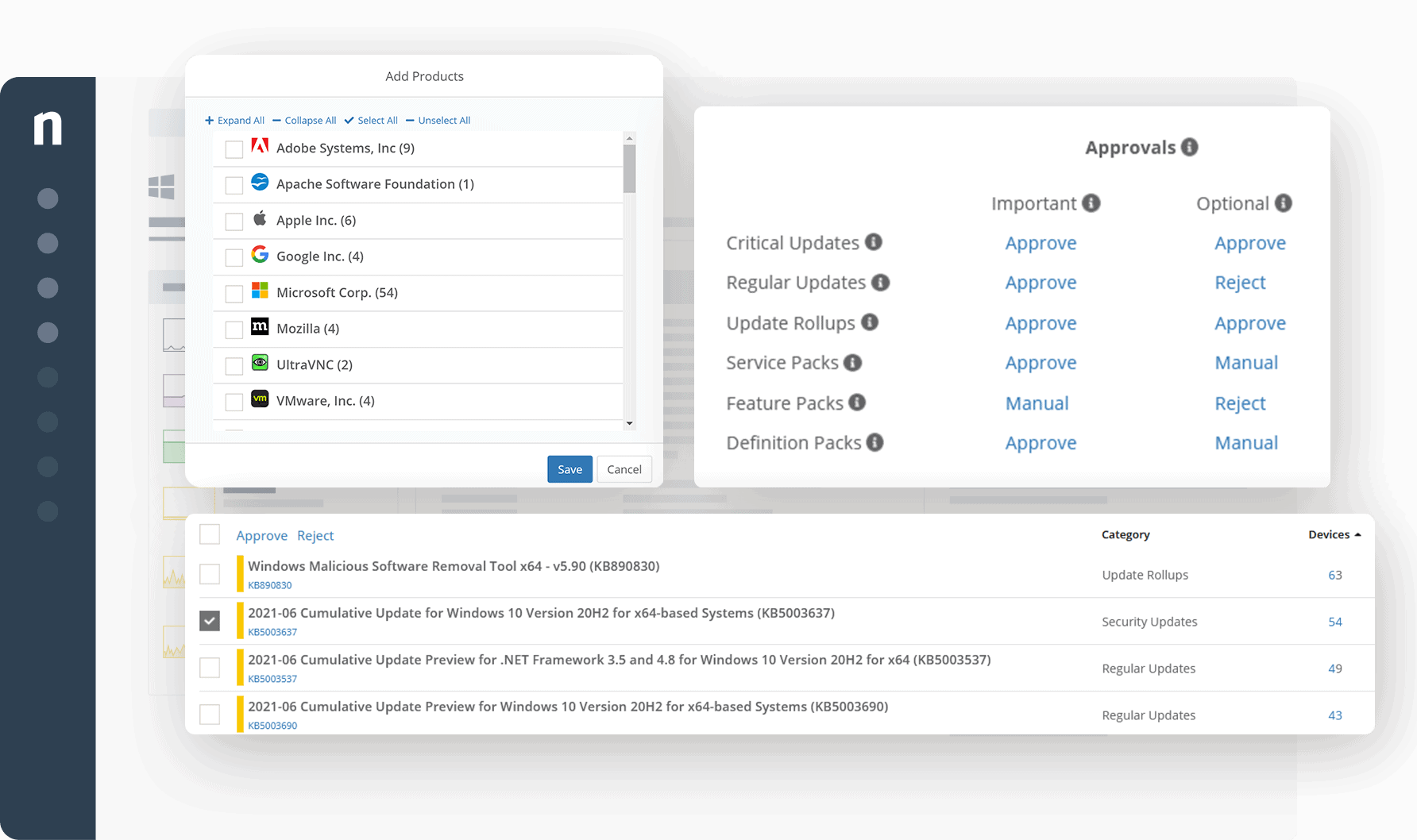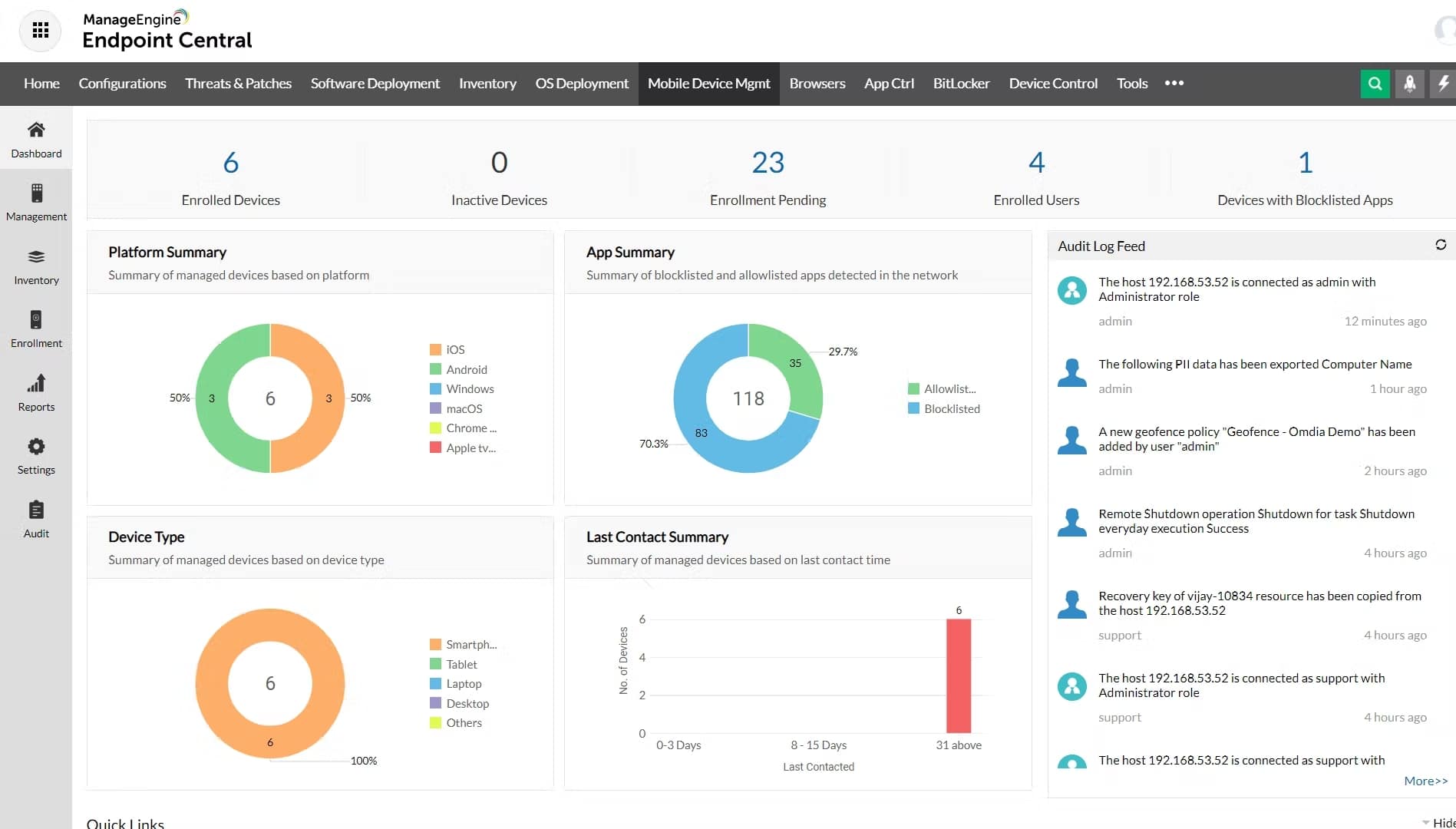We may earn a commission if you make a purchase through the links on our website.
The Best SCCM Alternatives
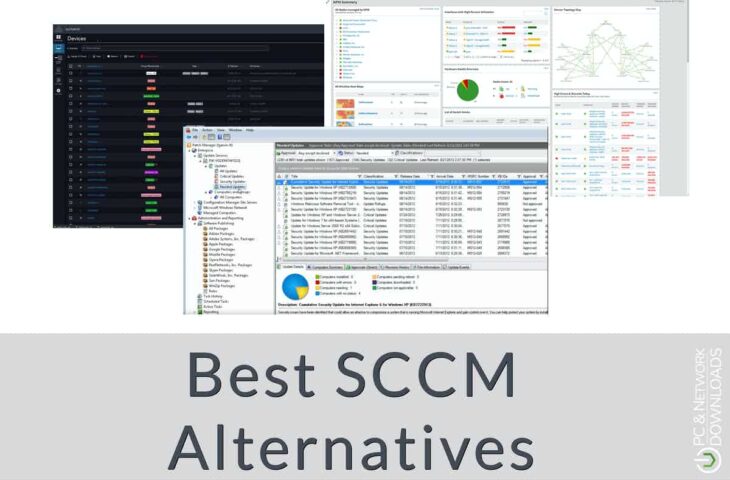
UPDATED: October 2, 2024
SCCM is limited in its scope—take advantage of these alternatives to improve your deployment and administration.
While SCCM is an incredibly useful tool, it is limited by its direct association with Windows. There are a variety of alternatives available that can drastically enhance the scope of the tool to include a broader range of support.
This article discusses distinct SCCM alternatives that can enhance your SCCM tool capabilities. This includes expanding the solution to other platforms such as macOS and Linux, or including integration for a greater quantity of third-party software solutions for patching and deployment. The solutions also come with additional features that are not typically associated with SCCM but go hand in hand, such as security controls and expanded endpoint visibility. You may also require better automation and scheduling support, which comes as standard with all of the solutions that are featured.
Regardless of your business needs, or your platform requirements, you will undoubtedly find an SCCM alternative from amongst the options in this article.
Here is our list of the best SCCM Alternatives:
- NinjaOne Patch Management – EDITOR'S CHOICE This cloud-based system automates patching on any system and it is useful for IT operations teams and managed service providers. Access a 14-day free trial.
- ManageEngine Endpoint Central – FREE TRIAL Provides patching and software rollout for desktops, but also includes laptop and mobile rollout support with remote deployment features. Start a 30-day free trial.
- SecPod SanerNow CyberHygiene Platform A SaaS platform that provides vulnerability scanning, patching for macOS, Linux, Windows, and software packages, and compliance reporting.
- SolarWinds Patch Manager A simple but incredibly useful tool that integrates with your existing WSUS and SCCM components to enhance their capabilities, instead of replacing them wholesale.
- Automox A cloud-based enterprise-grade solution that can comprehensively overhaul your SCCM environment across all platforms, including a large quantity of third-party software support.
- JumpCloud A cloud-based directory management solution that boasts a ‘directory-as-a-service’ mindset that provides straightforward management and granular support.
- Jamf An enterprise-grade SCCM alternative built from the ground up for Apple products, including macOS, Apple TV, iPad, and iPhone—all in one solution.
- Munki An open-source macOS SCCM tools alternative that provides the capabilities of SCCM while being both free and macOS-focused.
- KACE Unified Endpoint Manager A collection of advanced netadmin products that when combined can not only replace SCCM but also categorically advance your entire network management infrastructure.
The Best SCCM Alternatives
Our methodology for selecting SCCM alternatives
We reviewed various SCCM alternatives and analyzed the options based on the following criteria:
- Scalability
- Integration into other platforms
- Support for third-party application patching
- Graphical interpretation of data, such as charts and graphs
- A free trial period, a demo, or a money-back guarantee for no-risk assessment
- A good price that reflects value for money when compared to the functions offered
1. NinjaOne Patch Management – FREE TRIAL
NinjaOne Patch Management is a SaaS package that is offered from a cloud platform of system management and monitoring tools. The architecture of the NinjaOne platform is multi-tenanted, which enables MSPs to keep the data of their clients separate. However, the Patch Management tool and all of the other systems offered by NinjaOne are equally suitable for use by IT operations teams.
Key Features:
- Patch Anywhere: Seamlessly patch devices regardless of their location, ensuring consistent software updates across the network.
- Update Tracking: Keeps track of OS and software update availability, enabling proactive patch management.
- Patching Profiles: Allows the creation of patching profiles to define maintenance windows and automate patch deployment.
- Patch Testing and Approval: Provides options for patch testing and approval, ensuring the reliability and stability of software updates.
- Dependency Identification: Identifies patch dependencies for proper rollout ordering, minimizing potential conflicts during deployment.
Why do we recommend it?
NinjaOne Patch Management offers a seamless and efficient approach to patching devices, regardless of their location. Whether you're managing a single IT environment or serving multiple clients as an MSP, NinjaOne's multi-tenanted architecture ensures data separation and security. With features like patching profiles, patch testing, and automated patch deployment, NinjaOne simplifies the patch management process with minimal manual intervention. We recommend NinjaOne Patch Management for its platform-agnostic web-based management, which allows IT operations teams and MSPs to effortlessly maintain and update software across diverse environments.
The NinjaOne Patch Management tool is designed to run with almost no manual intervention. The system will scan for software and create an inventory, then poll supplier feeds for notifications of patch availability. It then queues up the patches and runs them at the next available maintenance window.
Who is it recommended for?
NinjaOne Patch Management is recommended for both IT operations teams and MSPs seeking a robust and automated patch management solution. Whether you're managing internal IT infrastructure or providing services to multiple clients, NinjaOne's flexible architecture caters to diverse needs. While designed primarily for desktop and server environments, NinjaOne Patch Management may not be suitable for organizations heavily reliant on mobile devices due to the lack of support in this area.
Pros:
- Silent Installation: Can install and uninstall applications and patches silently while users continue their work uninterrupted.
- Automated Maintenance: Easily schedule patch management and other maintenance tasks for increased efficiency.
- Platform Agnostic: Web-based management ensures compatibility across different operating systems and environments.
Cons:
- Limited Mobile Support: Lacks support for mobile devices, which may be a drawback for organizations with mobile-centric operations.
NinjaOne doesn’t publish a price list but you can get a quote. Access the software with a 14-day free trial.
EDITOR'S CHOICE
NinjaOne Patch Management is our top pick for an SCCM alternative because It is a robust tool designed for IT professionals seeking to streamline the software update process across multiple devices. Its user-friendly interface allows for easy navigation, enabling users to manage patches for various operating systems and applications efficiently. The automated patch deployment service reduces manual effort and minimizes downtime. Administrators can schedule updates to run during off-peak hours, ensuring that critical business operations remain uninterrupted. The platform also offers comprehensive reporting and monitoring tools, providing insights into patch status and compliance levels, which is crucial for maintaining security standards. NinjaOne’s integration capabilities with other IT management tools enhance its functionality, making it a versatile choice for Managed Service Providers (MSPs) and in-house IT teams alike. The ability to prioritize patches based on risk level adds an extra layer of security, allowing teams to focus on critical vulnerabilities first.
Download: Get a 14-day free trial
Official Site: https://www.ninjaone.com/freetrialform/
OS: Cloud based
2. ManageEngine Endpoint Central – FREE TRIAL
ManageEngine Endpoint Central is an endpoint management solution that can allow you to schedule and control patches and software deployment from a central product. Desktop Central excels in its capabilities as more than just a desktop service, as despite the name, it can also control laptop and mobile deployment with a variety of remote features.
Key Features:
- Desktop, Laptop, and Mobile Deployment: Manage endpoints across multiple platforms, including desktops, laptops, and mobile devices.
- Central Control Dashboard: Control patches and software deployment from a centralized dashboard, streamlining management tasks.
- Predefined Application Templates: Access over 4,500 predefined application templates for accelerated patch and software deployment.
- Endpoint Security Features: Enhance security posture with endpoint security features such as browser monitoring and application control.
- Remote Control Features: Utilize remote control features for troubleshooting and support tasks, improving endpoint management efficiency.
Why do we recommend it?
ManageEngine Endpoint Central offers robust endpoint management capabilities, allowing organizations to schedule and control patches and software deployment from a centralized dashboard. With support for desktops, laptops, and mobile devices, it provides comprehensive coverage for endpoint management needs. The platform's extensive library of predefined application templates accelerates patch and software deployment, while its endpoint security features enhance overall security posture. We recommend ManageEngine Endpoint Central for organizations seeking a flexible and feature-rich solution for endpoint management across diverse environments.
The product comes with more than 4,500 predefined application templates that massively speed up patch and software deployment across your network. Additionally, the product handles automated OS imaging and deployment. Recently, ManageEngine updated the product to include new endpoint security features such as browser monitoring and application control.
Who is it recommended for?
ManageEngine Endpoint Central is recommended for IT administrators and managed service providers (MSPs) tasked with managing endpoints across desktop, laptop, and mobile devices. Its flexible deployment options, support for both Windows and Linux platforms, and integrated reporting capabilities make it suitable for organizations of all sizes. However, due to its feature-rich nature, it may require some time to fully explore and learn, making it ideal for organizations willing to invest in comprehensive endpoint management.
Pros:
- Flexible Deployment Options: Supports deployment across desktop, laptop, and mobile devices, catering to diverse endpoint environments.
- Cross-Platform Support: Can be installed on both Windows and Linux platforms, offering flexibility in deployment.
- Comprehensive Reporting: Offers in-depth reporting capabilities, ideal for enterprise management and MSPs.
- Extensive Application Integration: Integrated into more applications than most patch management solutions, providing comprehensive endpoint management capabilities.
Cons:
- Learning Curve: Due to its feature-rich nature, ManageEngine Endpoint Central may require time to fully explore and learn, particularly for new users.
The software comes with a 30-day free trial for both the cloud and on-prem editions. There is also a completely free edition designed for small businesses, that can cover up the 25 devices.
The full product comes as either a Professional Edition or an Enterprise Edition which includes additional control and security features. Finally, there is a UEM Edition that expands the product to include the full lineup of mobile management features.
3. SecPod SanerNow CyberHygiene Platform
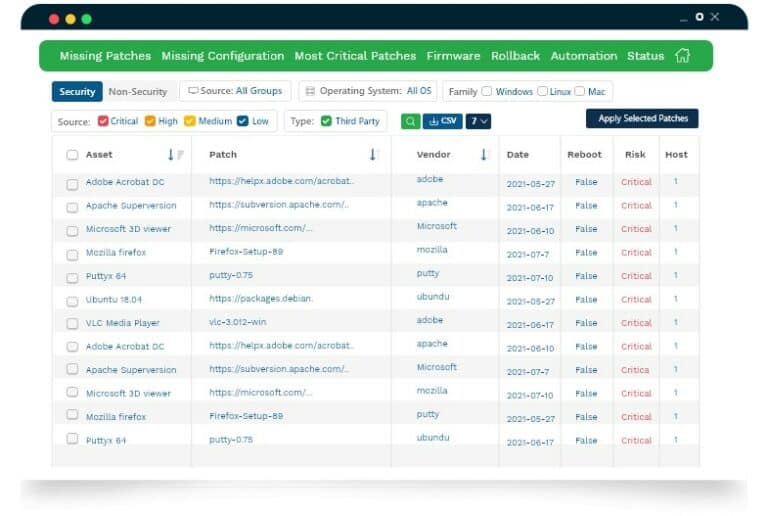
SanerNow CyberHygiene Platform is a cloud platform that offers a package of vulnerability management with patching and compliance reporting. The vulnerability management services of this SaaS package provide functionality that SCCM won’t give you. It scans for a list of 160,000 vulnerabilities. The patch manager will resolve the problems of outdated operating systems and software.
Key Features:
- Hardware and Software Inventories: Gain visibility into hardware and software assets across your network.
- Vulnerability Scanning: Scan for over 160,000 vulnerabilities to identify security risks and configuration weaknesses.
- Cross-Platform Patching: Patch Windows, macOS, and Linux systems, addressing outdated operating systems and software.
- Patch Management: Access a library of patches for over 400 software packages, ensuring timely updates to mitigate security risks.
- Compliance Reporting: Generate compliance reports for standards such as HIPAA, PCI DSS, NIST, and ISO to meet regulatory requirements.
Why do we recommend it?
SecPod SanerNow CyberHygiene Platform offers a comprehensive package of vulnerability management, patching, and compliance reporting, filling the gaps left by traditional solutions like SCCM. With its cloud-based console and endpoint agents, SanerNow scans for over 160,000 vulnerabilities, addressing both patching requirements and configuration weaknesses. We recommend SanerNow for organizations seeking a centralized solution for vulnerability management, patching, and compliance reporting across their endpoints and cloud platforms.
The console for the system is based in the cloud but the system installs agents on endpoints and cloud platforms. While the scanner provides solutions to fix discovered misconfigurations, the integrated patch manager updates out of date operating systems and software.
SanerNow has a list of 400 software systems and it regularly queries their providers for patches. When one is available, the system verifies each installer and stores it in a library. When the patch manager that operates for an account holder creates a software inventory, the system compares the patch status of each package. Where the software is discovered to be out of date, the patch manager rolls out patches that are taken from the library.
Who is it recommended for?
SecPod SanerNow CyberHygiene Platform is recommended for IT professionals and security teams looking to streamline vulnerability management, patching, and compliance reporting processes. Whether managing endpoints or cloud platforms, SanerNow offers multi-site management capabilities and support for compliance standards such as HIPAA, PCI DSS, NIST, and ISO. However, organizations with a diverse software ecosystem may find the patching support limited to the platform's database of 400 software packages.
Pros:
- Comprehensive Security Coverage: Scans for patching requirements and configuration weaknesses, addressing a wide range of security risks.
- Extensive Vulnerability Database: Access a database of over 160,000 vulnerabilities for thorough vulnerability management.
- Multi-Site Management: Manage endpoints and cloud platforms across multiple sites from a centralized console.
- Compliance Reporting: Generate compliance reports for regulatory standards, facilitating adherence to industry regulations.
- Cloud-Based Console: Enjoy the flexibility of a cloud-based console for easy management and deployment.
Cons:
- Limited Patching Support: Patching is limited to the platform's database of 400 software packages, potentially excluding less common applications or custom software.
All of the activities of the SanerNow platform are logged and the stored records that the service compiles can be used for compliance reporting for HIPAA, PCI DSS, NIST 800-53, NIST 800-171, and ISO. You can assess the SanerNow CyberHygiene Platform with a 30-day free trial.
4. SolarWinds Patch Manager
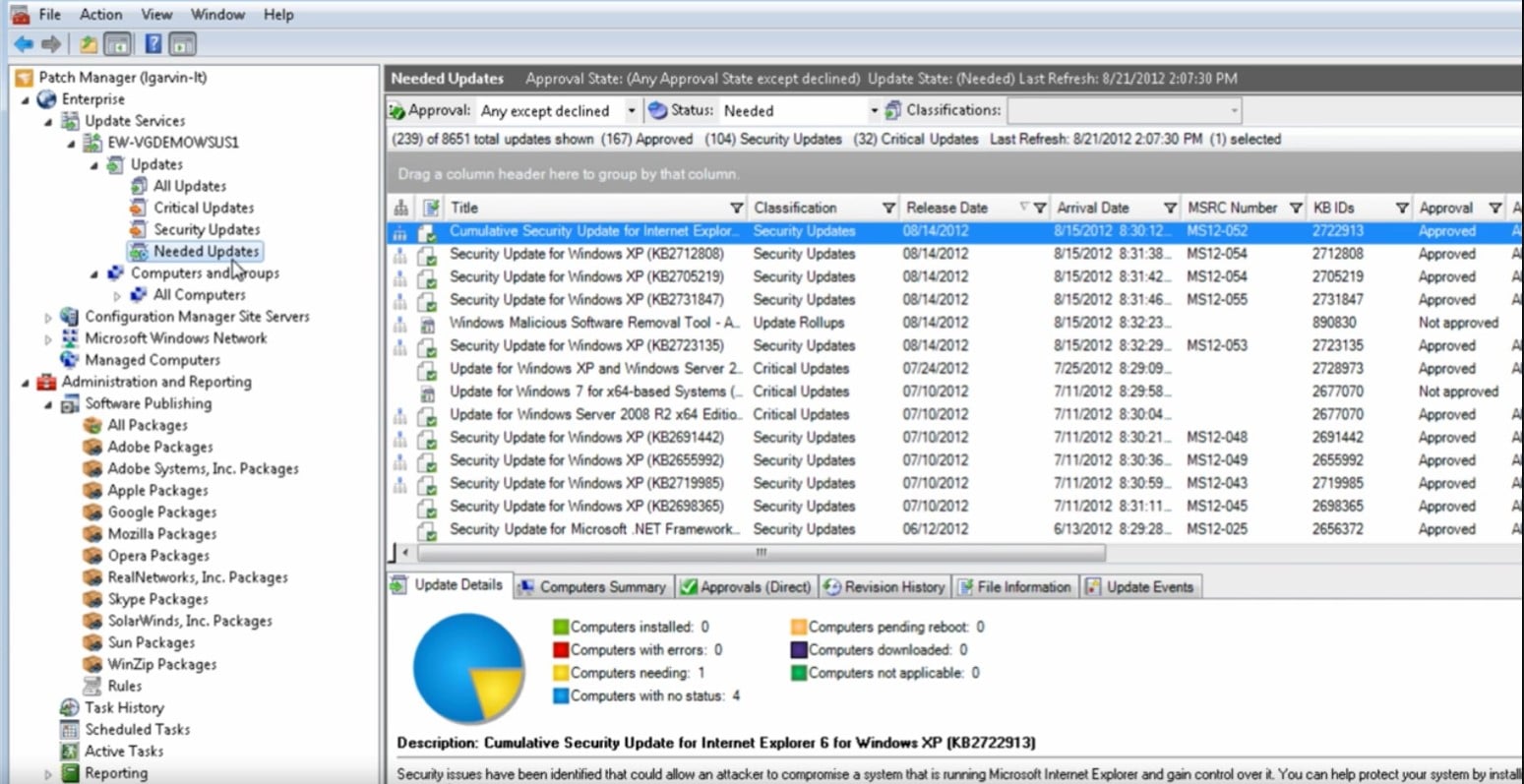
SolarWinds Patch Manager is a SolarWinds product that can comprehensively overhaul your SCCM environment, but differently than most products featured in this article. As the name implies, the focus of this product is on managing updates rolled out through WSUS, and instead integrates with SCCM tools rather than replacing it to enhance the capabilities of the available systems.
Key Features:
- WSUS Patch Management: Comprehensive management of updates rolled out through WSUS, enhancing patch deployment capabilities.
- SCCM Overhaul and Integrations: Seamlessly integrates with SCCM tools to enhance patch management processes and streamline deployment.
- Status and Compliance Reporting: Provides detailed status and compliance reports to ensure patching activities meet organizational requirements.
- Improved Update Automation: Enhances patch automation with detailed scheduling options, even targeting powered-off devices for efficient patch deployment.
- Variety of Third-party Integrations: Supports a wide range of third-party update integrations, reducing the hassle of updating across the network.
Why do we recommend it?
SolarWinds Patch Manager offers a unique approach to patch management, specifically tailored to enhance your SCCM environment rather than replace it. With a focus on managing updates through WSUS and seamless integration with SCCM tools, Patch Manager provides comprehensive capabilities to streamline patch management processes. We recommend Patch Manager for its ability to extend WSUS patching with status and compliance reporting, improved update automation, and support for a variety of third-party integrations. Whether you're managing a small network or a large enterprise environment, Patch Manager simplifies patch management tasks and enhances overall efficiency.
You can very easily manage patches across your network, and extend WSUS patching to feature status and compliance reports. The solution provides better patch automation, with detailed scheduling options included that can even target powered-off devices. Patch Manager has a variety of third-party update integrations that can drastically decrease the hassle of updating across your network.
Who is it recommended for?
SolarWinds Patch Manager is recommended for organizations of all sizes seeking a robust patch management solution integrated with SCCM. Whether you're an IT administrator, network manager, or system engineer, Patch Manager provides a simple dashboard for tracking and visualizing patch progress across your network. While primarily enterprise-focused, Patch Manager can also benefit small to medium-sized businesses looking to streamline patch deployment processes. However, it may not be the best option for home labs or very small networks due to its enterprise-centric features and capabilities.
Pros:
- Simple Dashboard: Easy-to-use dashboard for tracking and visualizing patch progress, suitable for both small and large networks.
- Integrated with SCCM: Direct integration with SCCM for smoother patch deployment and management processes.
- Supports Third-Party Patching: Offers support for various third-party patching options, enhancing flexibility and compatibility.
Cons:
- Enterprise Focus: Primarily targeted towards enterprise environments, may not be ideal for home labs or very small networks.
As is typical with SolarWinds product lineup, it comes with a 30-day free trial. The product itself has both subscription and perpetual license options that can be quoted from the website.
5. Automox
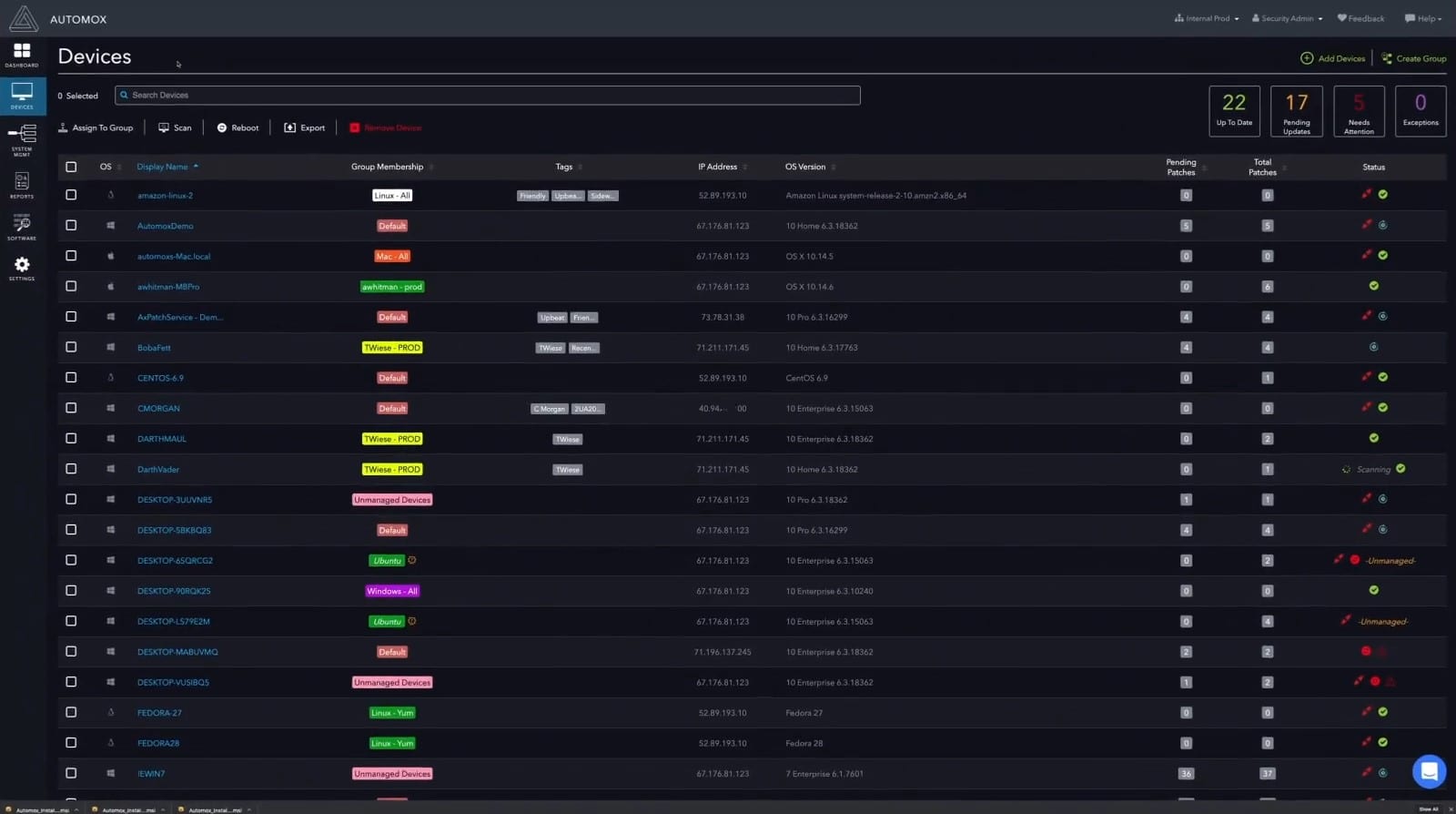
Automox provides a comprehensive, enterprise-grade tool that completely replaces SCCM while encompassing Windows, macOS, and Linux endpoints all through a cloud-based configuration. It provides automated patch rollout for OS and supported third-party software, as is expected from SCCM tools—but it also includes expansive software & hardware visibility to detect misconfigurations with ease.
Key Features:
- Windows, macOS, and Linux Support: Provides patch management for diverse endpoint environments, including Windows, macOS, and Linux.
- Cloud-Based Management: Enables centralized management of endpoints across remote sites from a single cloud-based platform.
- Lightweight Agent Rollout: Utilizes a lightweight agent for automated policy enforcement and device targeting without significant resource overhead.
- Hardware & Software Visibility: Offers expansive visibility into hardware and software configurations to detect misconfigurations and vulnerabilities easily.
- Automated Policy and Security Control: Facilitates automated policy enforcement and security control, enhancing overall security posture.
Why do we recommend it?
Automox offers a comprehensive, cloud-based solution that replaces SCCM and provides automated patch management for Windows, macOS, and Linux endpoints. With expansive software and hardware visibility, it enables easy detection of misconfigurations, enhancing overall security posture. The lightweight agent facilitates automated policy enforcement and device targeting, making it ideal for enterprise-scale businesses with multiple remote sites. Automox's support for custom scripts allows for flexible patching workflows, catering to diverse organizational needs.
The product works via a lightweight distributed agent that can allow you to automate policy enforcement, device targeting, and a variety of other useful administration functions. The cloud-based nature of the solution means you can manage vast enterprise-scale businesses at numerous remote sites, all from a single solution. It is the perfect product for businesses that need a massive multi-platform SCCM replacement.
Who is it recommended for?
Automox is recommended for organizations in need of a scalable patch management solution that supports multi-platform environments. Its cloud-based management and lightweight agent make it suitable for businesses of all sizes, particularly those with distributed infrastructure. However, organizations seeking better patch prioritization and scheduling capabilities may require additional enhancements. Overall, Automox is ideal for businesses prioritizing automated policy enforcement and comprehensive endpoint visibility.
Pros:
- Highly Visual Interface: Utilizes colors and graphics to display top-level patching insights, enhancing usability and user experience.
- Support for Custom Scripts: Allows for the implementation of custom patching workflows through custom scripts, providing flexibility in patch management.
- Multi-Platform Patching: Supports patch management for Windows, Linux, macOS, and third-party applications such as Chrome and Adobe, catering to diverse endpoint environments.
- Scalable Pricing Model: Pricing is based on the number of endpoints, offering scalability for organizations of all sizes.
Cons:
- Patch Prioritization: May benefit from improved patch prioritization to better address critical vulnerabilities.
- Scheduling Enhancements: Scheduling capabilities could be improved to prevent accidental forced shutdowns and optimize patch deployment efficiency.
Automox comes with a 15-day free trial that boasts a 15-minute setup—though that undoubtedly depends on the scale of your working environment. The full product itself is divided into two separate packages: Patch and Manage.
The Patch solution is your basic SCCM replacement and features OS and third-party software automated updates, and costs $3 per device per month. The Manage solution includes all of the additional features such as policy enforcement and software enforcement and costs $5 per device per month.
6. JumpCloud
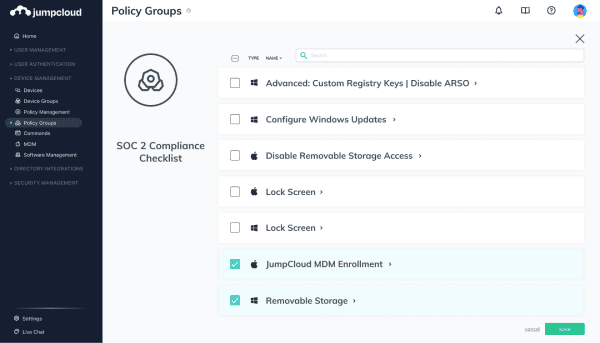
JumpCloud is a cloud-based directory management platform that allows complete control over your wider network by replacing SCCM tools through what they call a ‘directory-as-a-service’ solution. Through the centralized console, you can streamline user onboarding and access workflows, while performing administration tasks like user lockouts and password expiration management.
Key Features:
- Cloud-Based SCCM Replacement: Replaces SCCM tools with a cloud-based directory management platform, offering comprehensive network control.
- Secure Directory Services: Provides secure directory services with protocol-driven and agent-based access controls for broad or granular user settings.
- Event Logging and Monitoring: Offers event logging and monitoring capabilities to track user activities and ensure network security.
- API Automation: Facilitates automation of administrative tasks and workflows through API integrations, enhancing operational efficiency.
- User Access Control Settings: Enables streamlined user onboarding, access workflows, and administration tasks like user lockouts and password expiration management.
Why do we recommend it?
JumpCloud offers a cloud-based directory management platform that serves as a robust SCCM replacement, providing comprehensive control over network resources. Its ‘directory-as-a-service' solution enables streamlined user onboarding, access workflows, and administration tasks like user lockouts and password expiration management. With secure directory services, event logging, and API automation, JumpCloud ensures efficient network management while offering broad support for non-Microsoft systems and third-party integrations.
Because Jumpcloud is entirely cloud-based, it requires no additional hardware, and only a brief integration setup to get it working on your network. Access controls and security limits are protocol-driven and agent-based, allowing for broad or granular settings on your network users. Where JumpCloud excels is in its wider support over SCCM for non-Microsoft systems and third-party integrations.
Who is it recommended for?
JumpCloud is recommended for organizations seeking a cloud-based directory management solution with flexible access controls and broad platform support. It is ideal for companies prioritizing cloud flexibility and seamless integration with both on-premises and cloud resources. While it may not be suitable for those preferring LAN-based management tools, JumpCloud's free tier for up to ten users makes it an excellent option for smaller businesses looking to enhance their network management capabilities.
Pros:
- Cloud-Based Access Management: Allows access management via the cloud, even for on-premises resources, providing flexibility and scalability.
- Support for Non-Microsoft Systems: Provides Active Directory access through a GUI in Linux, offering broad platform support.
- Free Tier for Smaller Businesses: Offers a free tier for up to ten users, making it suitable for smaller businesses with limited budgetary resources.
Cons:
- Not Suitable for LAN-Based Management: May not be ideal for organizations preferring LAN-based management tools, as JumpCloud is entirely cloud-based.
JumpCloud has a 10-day free trial available through the platform, once you have signed up for access, which is also permanently free for the first 10 users. The base product itself is around $2 per user per month, but you are charged more for additional features. This provides ample flexibility in terms of pricing the product for your specific business needs.
However, the costs can ramp up significantly as you add more features and more users. To combat this, they also provide package deals that can alleviate some of the costs.
7. Jamf
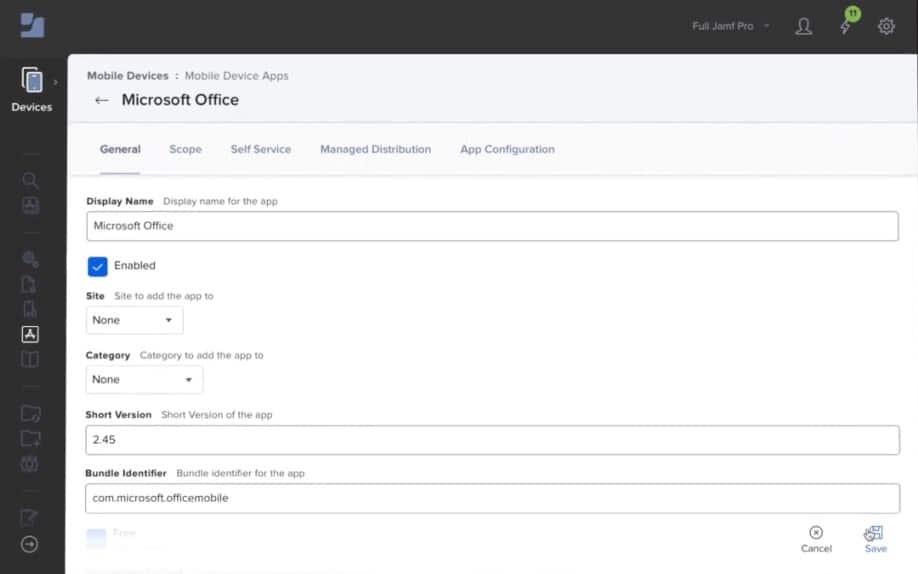
Jamf is an Apple-based SCCM alternative with a focus on enterprise-grade software and update distribution and management. It can support Apple Mac devices, but also includes Apple TV, iPad, and iPhone support to fully encompass all Apple-based products. If you are looking for enterprise-level SCCM tools alternative for your Apple-driven business, then this product is one of the best on the market.
Key Features:
- Apple-Focused SCCM Alternative: Tailored specifically for managing Apple devices, including Mac, iPad, iPhone, and Apple TV.
- Enterprise-Grade Feature Set: Offers an enterprise-grade feature set and support, including lifecycle management, configuration inventory, and enhanced security features.
- Lifecycle Management: Provides tools for managing the entire lifecycle of Apple devices, from deployment to retirement.
- Enhanced Security Features: Includes features to restrict malicious software, secure lost devices, and protect against data theft.
- Zero-Touch Deployment: Streamlines device deployment with zero-touch deployment options for seamless setup.
Why do we recommend it?
Jamf stands out as an Apple-focused SCCM alternative designed specifically for enterprises heavily invested in Apple products. With comprehensive support for Apple Mac devices, as well as Apple TV, iPad, and iPhone, Jamf offers an enterprise-grade feature set and support tailored to Apple-driven businesses. Its Jamf Pro product enhances administration capabilities with lifecycle management, configuration inventory, and robust security features, making it one of the best solutions for managing Apple devices in an enterprise environment.
The Jamf Pro product is really where the solution shines. It enhances your administration capabilities to include features such as lifecycle management, configuration inventory, and a broad range of security features. You can restrict malicious software while deploying simultaneous patches throughout your on-prem and external endpoints.
Who is it recommended for?
Jamf is recommended for enterprises seeking an SCCM alternative focused on managing Apple devices. It is ideal for organizations heavily invested in Apple products, including Mac devices, iPad, iPhone, and Apple TV. While Jamf Pro offers advanced features for comprehensive device management, it may not be suitable for businesses primarily using non-Apple devices. However, for Apple-driven businesses, Jamf provides a sleek and intuitive dashboard interface, playbooks for device policy templatization, and advanced security features.
Pros:
- Sleek and Intuitive Dashboard Interface: Offers a sleek and intuitive dashboard interface for easy device management.
- Playbooks and Blueprints: Utilizes playbooks and blueprints to templatize device policies, simplifying configuration and deployment.
- Lost Device Recovery: Enables recovery of lost devices and secures them from data theft with built-in security features.
Cons:
- Limited Device Support: Only supports iOS devices, which may not be suitable for organizations with diverse device ecosystems.
- Platform Dependency: Primarily tailored for Apple devices, making it less suitable for organizations primarily using non-Apple devices.
There is a free trial available for both the standard and pro versions of the product through the company website. The full product itself can be purchased through a variety of available packages. The fundamentals and business plans are perfect if you just need the basic features of the product, and cost either $4 per device or $12.60 per user respectively.
Jamf Pro can also be purchased individually and is the main product you will be interested in as an advanced SCCM alternative. It costs around $3.33 per mobile device or $7 per macOS device.
8. Munki
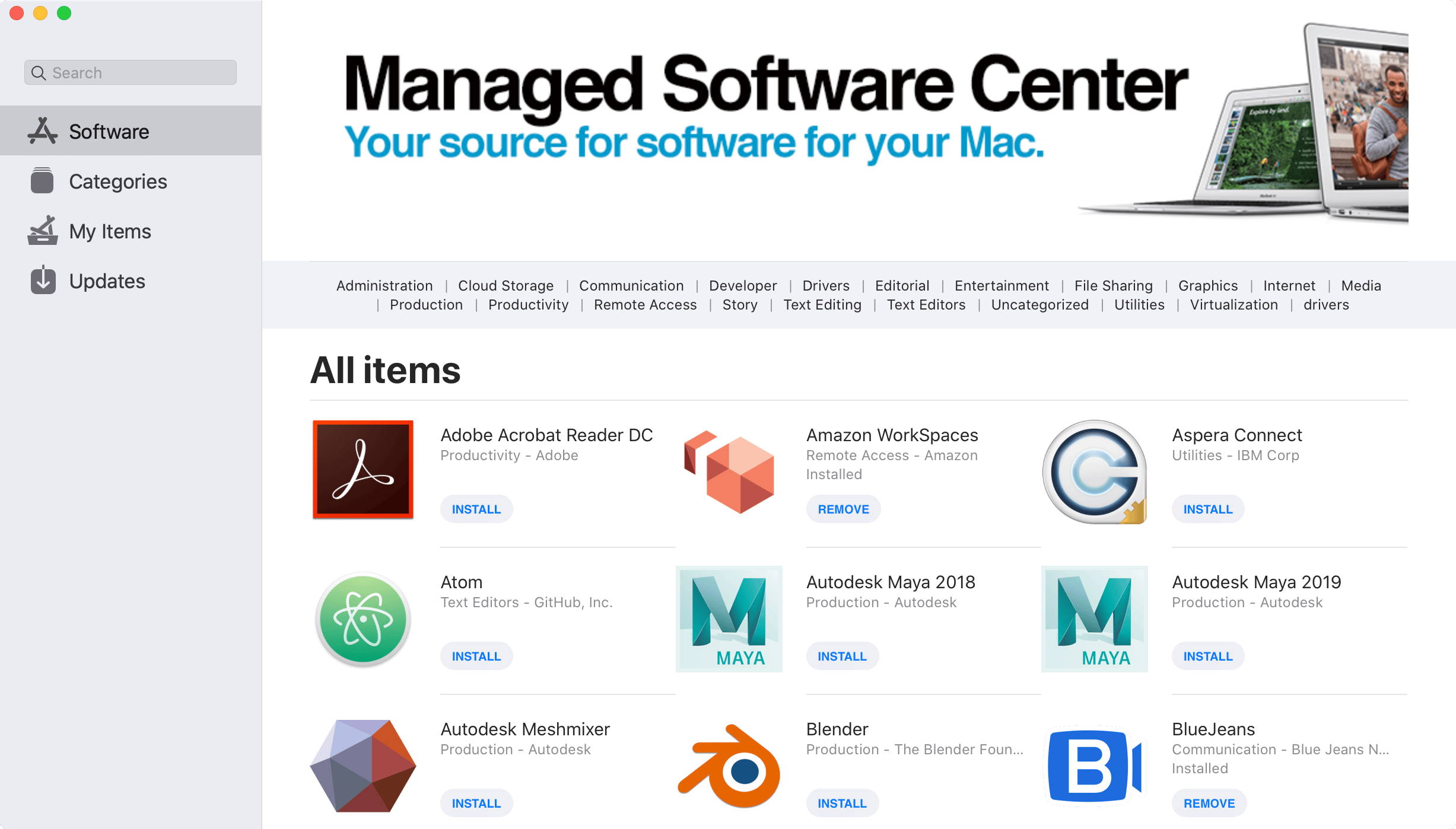
Munki is effectively an open-source SCCM equivalent built specifically for macOS. It cannot be considered a complete replacement for SCCM tools, as it does not support Windows machines, but if your company is Mac driven and needs something akin to SCCM—then Munki is perfect for your requirements. The software requires a fairly in-depth setup, but once on your network, can handle the distribution and updating of a variety of software installations.
Key Features:
- Open-Source macOS SCCM Equivalent: Built specifically for macOS environments, offering SCCM-like functionality for software deployment and update management.
- Apple and Third-Party Software Installations: Supports the distribution and updating of both Apple and third-party software installations.
- Software and OS Updates: Facilitates software and OS updates to ensure systems are up to date with the latest patches and versions.
- Simple and Intuitive Interface: Provides a simple and intuitive interface for easy software management and updates.
- Wide Range of Third-Party Apple Applications: Supports a wide range of third-party Apple applications, enhancing compatibility and flexibility.
Why do we recommend it?
Munki is an open-source macOS SCCM equivalent tailored specifically for macOS environments. While it may not replace SCCM for organizations with diverse device ecosystems, it's perfect for Mac-driven companies seeking SCCM-like functionality. Munki excels in handling the distribution and updating of both Apple and third-party software installations, as well as software and OS updates. With its simple and intuitive interface and robust support, Munki effectively fulfills the software deployment and update management needs of macOS environments.
Munki does not provide many of the other features that numerous solutions in this article can provide. For example, Munki cannot perform OS imaging, remote assistance, or preference management. The software is designed to fit a very specific function, but since it is open-source, it generally fulfills that function very well with ample support, while also being completely free.
Who is it recommended for?
Munki is recommended for organizations heavily reliant on macOS devices and seeking an open-source SCCM alternative. It's ideal for companies with larger Mac-based networks that require efficient software deployment and update management. While Munki may not offer advanced features like OS imaging or remote assistance, its focus on macOS compatibility makes it a valuable tool for Mac-driven organizations looking for a cost-effective solution for software management.
Pros:
- Open-Source Platform: Offers an open-source platform with ample support, making it accessible and cost-effective.
- Simple and Intuitive Dashboards: Features simple and intuitive dashboards and interface for easy software management.
- Wide Range of Third-Party Apple Applications: Supports a wide range of third-party Apple applications, enhancing compatibility and flexibility.
- Ideal for Larger Mac-Based Networks: Perfect for organizations with larger Mac-based networks requiring efficient software deployment and update management.
Cons:
- Designed Specifically for macOS: Limited to macOS environments and cannot replace SCCM for organizations with diverse device ecosystems.
- Lacks Advanced Features: Does not offer advanced features like OS imaging or remote assistance, limiting its functionality compared to other solutions.
Munki is completely free and has no available premium options or features. You can find the solutions GitHub page here for more comprehensive details on how it can be installed, and what features you can expect.
9. KACE Unified Endpoint Manager
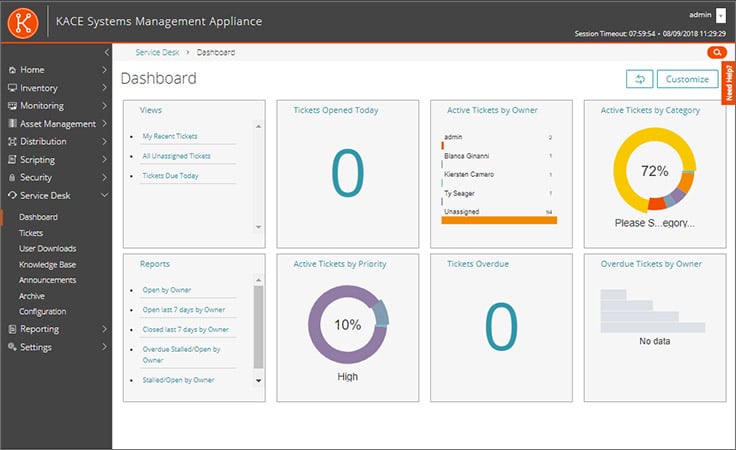
KACE by Quest includes several components that can drastically overhaul your network infrastructure, one of which is the Unified Endpoint Manager which provides all of the functionality of SCCM tools and more. Combined with the other components of KACE, such as the Systems Deployment Appliance which can automatically capture and distribute images across your network, you can fully automate the rollout of software, patches, and images across your entire large-scale enterprise network.
Key Features:
- Centralized Systems Management: Provides centralized management of endpoint devices and network infrastructure.
- Automated Administrative Tasks: Automates administrative tasks to streamline operations and improve efficiency.
- Compliance Reporting: Generates compliance reports to ensure adherence to regulatory requirements and industry standards.
- Network Security Features: Includes network security features to protect against threats and vulnerabilities.
- Flexible Product Lineup: Offers a flexible product lineup with customizable solutions tailored to meet the specific needs of organizations.
Why do we recommend it?
KACE Unified Endpoint Manager, part of the KACE suite by Quest, offers a comprehensive solution for network infrastructure management, providing all the functionality of SCCM tools and more. With features like centralized systems management, automated administrative tasks, compliance reporting, and network security features, KACE Unified Endpoint Manager enables organizations to efficiently manage their large-scale enterprise networks. Its integration with other KACE components, such as the Systems Deployment Appliance, allows for seamless automation of software rollouts, patch deployment, and system imaging across the network.
KACE also includes some of the other features you might expect from a premium enterprise-grade SCCM alternative. Automated administration tasks and scheduled patch deployment are among some of its available net admin tools. While compliance requirement reporting and remote criteria-based settings help improve your network security.
Who is it recommended for?
KACE Unified Endpoint Manager is recommended for large-scale enterprises seeking an all-encompassing solution for network infrastructure management. It is suitable for organizations looking to streamline administrative tasks, ensure compliance, and enhance network security. While it may not be ideal for MSPs or larger multi-site organizations, KACE Unified Endpoint Manager provides robust features and capabilities for organizations with extensive network infrastructure management needs.
Pros:
- Comprehensive Device Management: Manages devices and licensing information, offering a comprehensive approach to network management.
- Built-in Vulnerability Scanning and Patching: Includes built-in vulnerability scanning and patching capabilities to ensure systems are up to date and secure.
- Simple Dashboard Interface: Features a simple dashboard interface that provides a clutter-free view of important metrics, enhancing usability and accessibility.
Cons:
- Not Suited for MSPs or Larger Multi-Site Organizations: May not be ideal for MSPs or larger multi-site organizations with complex network management requirements.
- Pricing Requires Contacting Sales Team: Pricing information is not readily available and requires contacting the sales team, which may be inconvenient for some organizations.
KACE itself is divided into a total of 6 separate products (7 if you include the additionally recommended RemoteScan). All of these products have individually available free trials, but the main product you will be interested in as an SCCM alternative is the Unified Endpoint Manager. You can request a personalized price quote on all of the products that you are interested in by contacting Quest directly.
SCCM Alternatives FAQs
What are the key features of SCCM?
The key features of SCCM include software distribution, operating system deployment, inventory management, software metering, and compliance reporting.
What is the difference between SCCM and Group Policy?
SCCM and Group Policy are both systems management solutions, but SCCM provides more comprehensive management capabilities, including software distribution, operating system deployment, and inventory management. Group Policy, on the other hand, focuses on managing policies and settings for Windows-based computers in an Active Directory environment.
How does SCCM work?
SCCM works by using agents installed on client computers to communicate with the SCCM server and receive software updates, software deployments, and other management tasks. The SCCM server acts as a central repository for software and configuration data, and provides a console for administrators to manage the environment.
